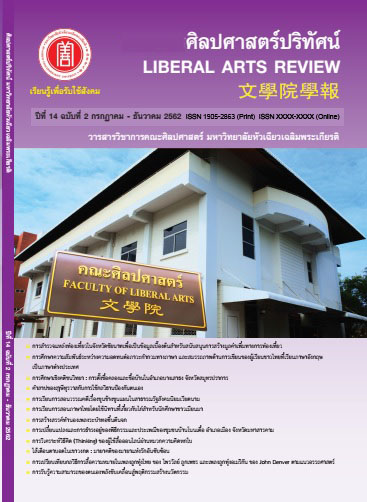การศึกษา ความสัมพันธ์ระหว่างความอดทนต่อภาวะกำกวมทางภาษา และสมรรถภาพ ด้านการเขียนของผู้เรียนชาวไทยที่เรียนภาษาอังกฤษ เป็นภาษาต่างประเทศ
คำสำคัญ:
ความอดทนต่อภาวะกำกวม, สมรรถภาพการเขียน, การเรียนรู้ทางภาษา, ผู้เรียนภาษาอังกฤษเป็นภาษาต่างประเทศบทคัดย่อ
งานวิจัยนี้มุ่งศึกษาความสัมพันธ์ระหว่างความอดทนต่อภาวะกำกวมทางภาษา (Ambiguity tolerance) และสมรรถภาพด้านการเขียนของผู้เรียนชาวไทย ที่เรียนภาษาอังกฤษเป็นภาษาต่างประเทศ โดยมีผู้เข้าร่วมในงานวิจัยเป็นนักศึกษามหาวิทยาลัยหัวเฉียวเฉลิมพระเกียรติ คณะศิลปศาสตร์ หลักสูตรภาษาอังกฤษ-ภาษาจีน จำนวน 103 คน เครื่องมือที่ใช้ในการวิจัย ได้แก่ แบบทดสอบภาวะกำกวมทางภาษา (Ely, 1995) และแบบทดสอบทางภาษาอังกฤษสำหรับผู้เรียนที่เรียนภาษาอังกฤษเป็นภาษาต่างประเทศ (TOEFL ITP) การวิเคราะห์ข้อมูลประกอบไปด้วยการวิเคราะห์ความแปรปรวน (ANOVA) การเปรียบเทียบค่าเฉลี่ยรายคู่ (Scheffe Post Hoc Test) และการหาค่าสหสัมพันธ์แบบเพียร์สัน (Pearson Correlation)
ผลการวิจัยพบว่า ความอดทนต่อภาวะกำกวมทางภาษาและสมรรถภาพการเขียนมีความสัมพันธ์กันอย่างมีนัยสำคัญ กล่าวคือถ้าผู้เรียนที่มีระดับความอดทนต่อภาวะกำกวมทางภาษามาก จะทำให้คะแนนของการทดสอบสมรรถภาพทางการเขียนมากขึ้นตามไปด้วย ทั้งนี้งานนี้วิจัยได้เสนอข้อเสนอแนะและการอภิปรายผลที่เกี่ยวข้อง อีกด้วย
เอกสารอ้างอิง
Brown, H. D. (2000). Principles of language teaching and learning. White Plains, NY: Longman.
Chapelle, C. (1983). The relationship between ambiguity tolerance and success in acquiring English as a second language in adult learners. Unpublished Doctoral Dissertation, Champaign, IL: University of Illinois at Urbana-Champaign.
Educational Testing Service (ETS). (2016). Test taker handbook: The TOEFL ITP assessment eries.NJ, USA.: Princeton.
Ehrman, M., & Oxford, R. (1990). Adult language learning styles and strategies in an intensive training setting. Modern Language Journal, 74(3), 311-327.
Ehrman, M., & Leaver, B. L. (2003). Cognitive styles in the service of language learning. System, 31, 393-415.
El-Koumy, A. S. A. (2000). Differences in FL reading comprehension among high-, middle-, and low-ambiguity tolerance students. Paper presented at the national symposium on nglish language teaching. Ain Shams University, Egypt (ED 445534), March 21-23.
Ely, C. M. (1995). Tolerance of ambiguity and the teaching of ESL. In Reid. J. M. (Ed.), Learning styles in the ESL/EFL classroom (pp. 87-95). NY: Heinle & Heinle Publishers.
Erten, I. H., & Topkaya, E. Z. (2009). Understanding tolerance of ambiguity of EFL learners in reading classes at tertiary level. Novitas-Royal, 3(1), 29-44.
Ezzati, M., & Farahian, M. (2016). Exploring tolerance of ambiguity and grammar achievement of advanced EFL learners. Journal for the Study of English Linguistics, 4(2), 1-12.
Hinkle, D.E., William,W., & Stephen G. J. (1998). Applied statistics for the behavior sciences (4th ed). NY: Houghton Mifflin.
Khamkhien, A. (2010). Factors affecting language learning strategy reported usage by Thai and Vietnamese EFL learners. Electronic Journal of Foreign Language Teaching, 7(1), 66-85.
Khamkhien, A. (2012). Demystifying Thai EFL learners’ perceptual learning style preferences. The Southeast Asian Journal of English Language Studies, 18(1), 61-74.
Khoshsima, H. (2017). An introduction to the ambiguity tolerance: As a source of variation in English-Persian translation. International Journal of Applied Linguistics & English Literature, 6(4), 91-103.
Kondo-Brown, K. (2006). Affective variables and Japanese L2 reading ability. Reading in a Foreign Language, 18(1), 55-71.
Krejcie, R.V., & Morgan, D.W. (1970). Determining sample size for research activities. Educational and Psychological Measurement, 30, 607-610.
Lee, E. (1999). The effects of tolerance of ambiguity on EFL task-based writing. Seoul National University. Retrieved from http://s-space.snu.ac.kr/bitstream/10371/70570/1/vol9_7.pdf
Liu, C. (2015). Relevant researches on tolerance of ambiguity. Theory and Practice in Language Studies, 5(9), 1874-1882.
Maxwell, A. (1965). A comparison of two English as foreign language tests. Unpublished manuscript, University of California (Davis).
Sa’dabadi, N. (2014). The relationship among level of ambiguity tolerance and cloze test performance of Iranian EFL learners across gender. International Journal of Language Learning and Applied Linguistics W orld (IJLLALW), 6(4), 337-347.
Samoilova, V., Thanh, V. D., & Wilang, J. D. (2017). Anxiety among engineering students in a graduate EFL classroom. Proceedings of the 3rd International Conference on Innovation in Education. (pp. 286-296). Thailand: Institute for Innovative Learning, Mahidol University.
Upshur, J. A. (1966). Comparison of performance on “Test of English as a Foreign Language” and “Michigan Test of English Language Proficiency.” Unpublished manuscript, University of Michigan.
ดาวน์โหลด
เผยแพร่แล้ว
รูปแบบการอ้างอิง
ฉบับ
ประเภทบทความ
สัญญาอนุญาต
บทความที่ได้รับการตีพิมพ์เป็นลิขสิทธิ์ของวารสารศิลปศาสตร์ปริทัศน์
ข้อความที่ปรากฏในบทความแต่ละเรื่องในวารสารวิชาการเล่มนี้เป็นความคิดเห็นส่วนตัวของผู้เขียนแต่ละท่านไม่เกี่ยวข้องกับมหาวิทยาลัยหัวเฉียวเฉลิมพระเกียรติ และคณาจารย์ท่านอื่นๆในมหาวิทยาลัยฯ แต่อย่างใด ความรับผิดชอบองค์ประกอบทั้งหมดของบทความแต่ละเรื่องเป็นของผู้เขียนแต่ละท่าน หากมีความผิดพลาดใดๆ ผู้เขียนแต่ละท่านจะรับผิดชอบบทความของตนเองแต่ผู้เดียว




